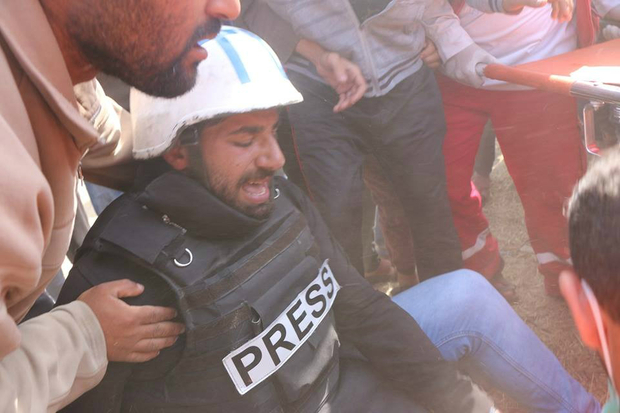Thousands of Palestinians were heading into a fifth Friday of protests in the besieged Gaza Strip as part of the “Great March of Return”, as the UN’s human rights chief slammed the Israeli army for the “deplorable” killing of 42 Palestinians in four weeks.
Israeli forces fired live ammunition and large amounts of tear gas towards demonstrators in the northern and southern Gaza Strip, an MEE correspondent reported.
In separate incidents, at least seven journalists were injured by Israeli forces while covering the protests. According to MEE’s correspondent, photojournalist Nabil Derbeih was shot in the head east of Jabaliya in northern Gaza, photographer Hashem Hamada was hit in the head with a tear gas canister east of Gaza City, while Abd al-Rahman al-Kahlout was shot in the leg in the same area.
Photographer Mohammed al-Masri suffered from excessive tear gas inhalation in the Jabaliya area, while journalists Iyad Abu Ghaza and Hassan Youssef were also reportedly wounded after being directly targeted with tear gas canisters east of al-Bureij refugee camp. Meanwhile, AlMayadeen news channel correspondent Lana Shaheen reportedly fainted due to tear gas east of Gaza City.
A press crew from Palestine TV was also directly targeted by tear gas canisters, causing the team of journalists to suffer from excessive tear gas inhalation.
Witnesses said at least two minors were shot in northern Gaza, including a teenage girl shot in the foot.
The Gaza ministry of health also reported that a field clinic east of al-Bureij was targeted with tear gas, severely affecting four paramedics.
According to the ministry, at least 168 Palestinians were wounded as of 5pm local time, including 12 minors and 11 medics and journalists.
East of Gaza City and the town of Jabaliya in northern Gaza, protesters reportedly removed sections of barbed wire installed by Israeli forces to prevent demonstrators from getting too close to the borderline with Israel.
A Friday for ‘revolutionary youth’
For nearly a month, demonstrators have been gathering every day several hundred metres from the fence separating Israel from Gaza, where almost 1.3 million of the small territory’s two million inhabitants are refugees, to demand the right to return to their pre-1948 homes.
The planned six-week protest is set to end on 15 May – the 70th anniversary of the Nakba (Catastrophe), in which more than 750,000 Palestinians were forced from their homes by Israeli forces during the 1948 Arab-Israeli war.
Youth groups inside Gaza have backed organisers’ calls to dedicate Friday’s protest to “revolutionary youth”, and have encouraged young Palestinians to take part.
More than 60 percent of Gaza’s population is under 24, while 56 percent of Gaza residents between the ages of 15 and 29 are unemployed, the highest rate of youth unemployment in the world according to the UN.
Palestinians believe the nearly 11-year Israeli blockade on Gaza – also upheld by Egypt – has led to deteriorating economic and social conditions in the tiny coastal territory.
At least four children have been killed and 454 wounded by Israeli forces as of 23 April, the UN Office for the Coordination of Humanitarian Affairs said on Friday.
But the US ambassador to the UN, Nikki Haley, echoed the Israeli government’s stance on Thursday by blaming Hamas, the ruling party in Gaza, for “using children as cannon fodder”.
She accused the group – which is one of several political parties supporting the march – of using civilians as human shields in the protests.
March organisers have repeatedly denied that Hamas was coordinating the protests, and have emphasised that the tens of thousands of demonstrators have been largely peaceful.
Israel slammed for ‘murderous assault’ against demonstrators
According to the Gaza health ministry, 40 Palestinians have been killed by Israeli forces since the beginning of the march on 30 March, and more than 5,500 have been wounded. The UN has tallied 42 Palestinian deaths during the same time period, including individuals not involved in the demonstrations.
No Israeli casualties have been reported.
MEE correspondents have repeatedly witnessed Israeli forces targeting paramedics and journalists throughout the demonstrations.
Two Palestinian journalists – Yasser Murtaja and Ahmad Abu Hussein – have been shot and killed since 30 March despite wearing clearly marked press jackets.
The secretary-general for the Democratic Press Association in Gaza, Rami al-Sharafi, said Israel was sending a message that “every journalist documenting the truth along the borderline [between Gaza and Israel] is an Israeli target”.
The Israeli army has rejected repeated pleas by the international community to use restraint and to conduct an independent inquiry into the deaths, maintaining the necessity of its open-fire policy.
Meanwhile, Amnesty International has called for a global arms embargo against Israel, accusing its forces of “carrying out a murderous assault” against Palestinians in the Gaza Strip.
Gaza’s health spokesman Ashraf al-Qidra said in a statement on Thursday that 21 injured Palestinians have had limbs amputated.
Rights group Adalah has stated that a number of Palestinians had to undergo amputations after Israeli authorities denied them permits to travel to the occupied West Bank for treatment, as hospitals in besieged Gaza have struggled to cope with the number of injuries in the past month.
The UN’s high commissioner for human rights meanwhile said on Friday that Israel must stop the excessive use of force and must hold to account those responsible for the deaths in the marches.
Zeid Raad al-Hussein said: “The loss of life is deplorable, and the staggering number of injuries caused by live ammunition only confirms the sense that excessive force has been used against demonstrators – not once, not twice, but repeatedly.
“It is difficult to see how children, even those throwing stones, can present a threat of imminent death or serious injury to heavily protected security force personnel.”
[Source: Middle East Eye]





 WhatsApp us
WhatsApp us 

